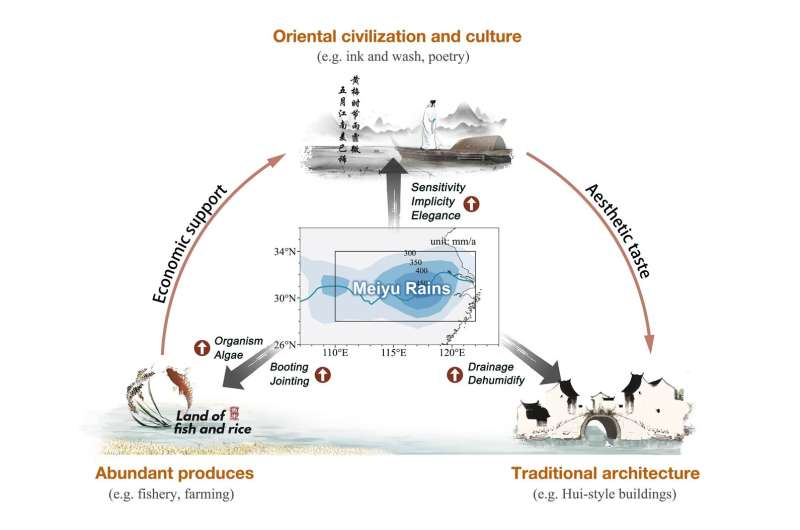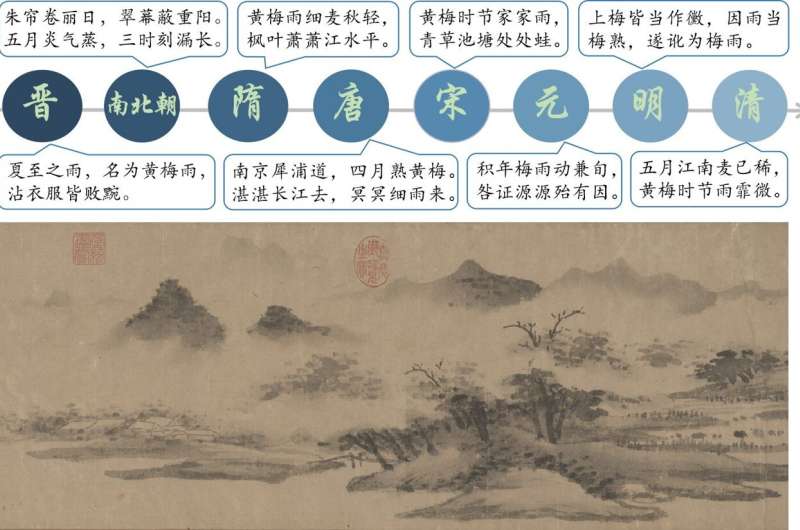
During early summer, a unique and far-reaching meteorological phenomenon occurs in China’s Yangtze River Basin and the main islands of Japan, known as Meiyu in China and Baiu in Japan. Traditional Meiyu-Baiu with significantly misty features has a long course in Asian history and has shaped civilization over thousands of years.
Although the traditional Meiyu-Baiu is closely linked to moldy damage, its continuous and gentle rain moistens the paddy rice at the jointing and booting stage. Meanwhile, the warm and moist conditions also promote the growth of organisms and algae in lakes and rivers, which provide an abundance of food to fisheries. Hence, the Meiyu region is often called “the land of fish and rice.”
The beauty of the traditional Meiyu also became a frequently used literary image. Numerous oriental poems, ink-and-wash paintings, and historical documents have consistently expressed feelings about “misty rains,” which can date back to at least the Jin Dynasty (265–420 AD).
However, in recent decades, both the Meiyu and Baiu have seldom exhibited their traditional misty features. But owing to the lack of quantitative metrics applicable to misty rains, there is still no consensus on whether the traditional Meiyu-Baiu has been declining significantly.
Although there have been studies on the detection and attribution of extreme Meiyu events (rainstorms or heat waves), traditional Meiyu is not an extreme event, and the existing conclusion cannot be directly transferred to its changes. There is no robust understanding of whether and to what extent the changes in the traditional Meiyu-Baiu can be attributed to global warming.

Professors Huijun Wang and Zhicong Yin et al constructed a three-dimensional deviation degree of misty rain (D2MR) for the first time, and found that the D2MR showed a significant upward trend both in Meiyu and Baiu region. This indicates that Meiyu-Baiu in East Asia has gradually lost its traditional characteristics of misty rain, especially in the Meiyu region.
82.5% (75.2–87.2%) and 81.1% (42.6–96.1%) of the D2MR trend in the Meiyu and Baiu regions, respectively, can be attributed to human activities, in which greenhouse gas forcing is the main factor, while the influence of aerosols is relatively insignificant. In a warmer future, the Meiyu-Baiu will continue to move further away from its traditional characteristics and enter the “new normal.”
The authors, from the Center for Climate System Prediction Research (CCSP), further state that human activity is much more active than in ancient times. Whether the suspension of the traditional misty rain is enough to promote and how it will promote the change of human social civilization in East Asia is still worthy of further discussion.
The ecosystem, energy system, and transportation network in East Asia may suffer huge losses due to the inability to adapt to the rapid transformation of Meiyu-Baiu to its extreme state, which requires the integration of more disciplines and government departments to tackle and respond.
More information:
Zhicong Yin et al, Traditional Meiyu-Baiu has been suspended by global warming, National Science Review (2024). DOI: 10.1093/nsr/nwae166
Citation:
Scientists say traditional characteristics of Meiyu-Baiu have disappeared due to global warming (2024, May 29)
retrieved 29 May 2024
from https://phys.org/news/2024-05-scientists-traditional-characteristics-meiyu-baiu.html
This document is subject to copyright. Apart from any fair dealing for the purpose of private study or research, no
part may be reproduced without the written permission. The content is provided for information purposes only.







